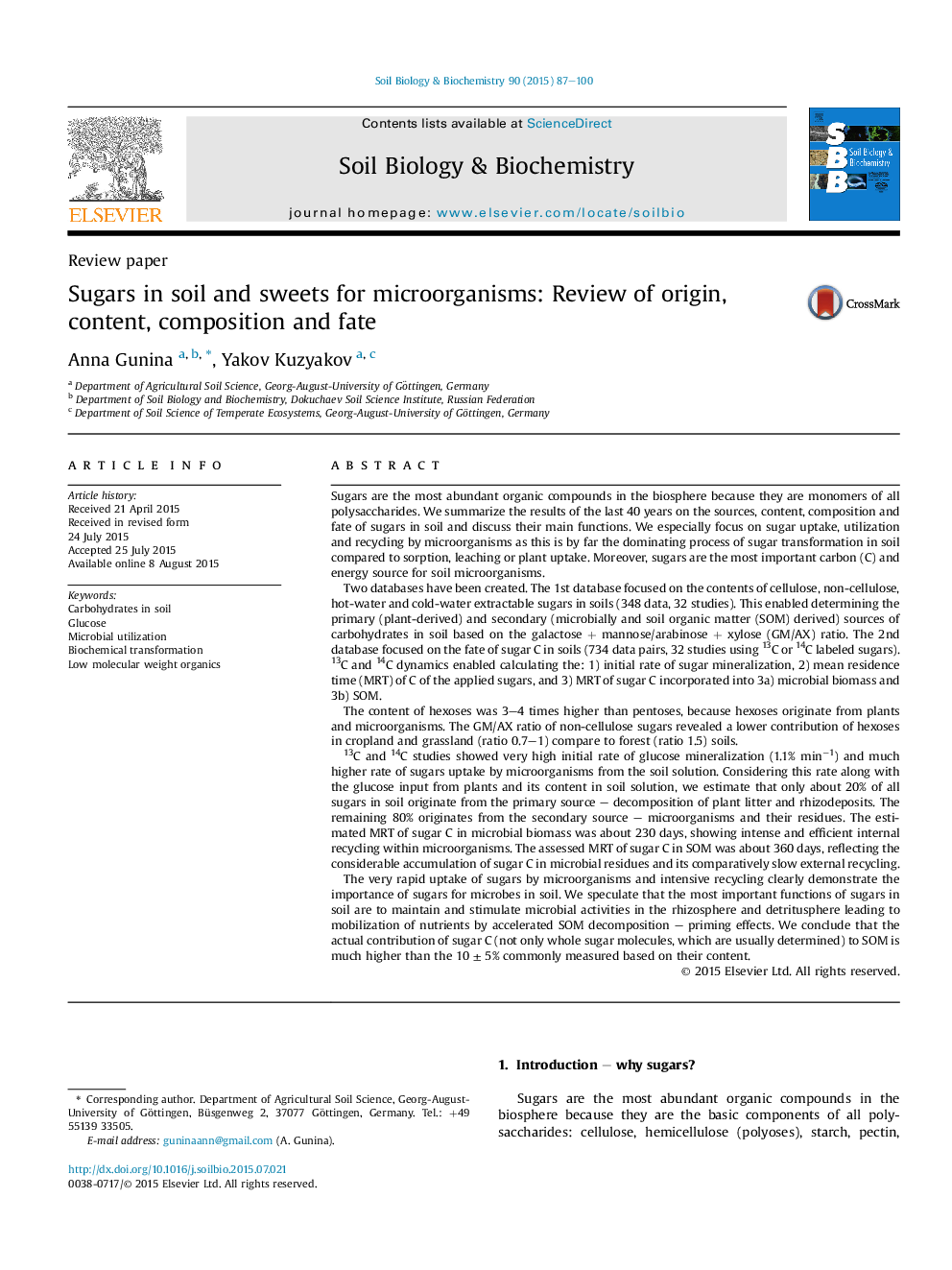| Article ID | Journal | Published Year | Pages | File Type |
|---|---|---|---|---|
| 2024382 | Soil Biology and Biochemistry | 2015 | 14 Pages |
•Sources, content and fate of sugars in soil and their main functions in soil were discussed.•GM/AX ratio of non-cellulose soil sugars depends on chemical composition of litter.•Initial rate of glucose mineralization in microbial biomass (MB) is 1.1% min−1.•1/5 of sugars in soil solution is from plant biomass, 4/5 is from recycling processes.•MRT of sugar C in SOM is 360 days due to accumulation of sugar C in dead MB.
Sugars are the most abundant organic compounds in the biosphere because they are monomers of all polysaccharides. We summarize the results of the last 40 years on the sources, content, composition and fate of sugars in soil and discuss their main functions. We especially focus on sugar uptake, utilization and recycling by microorganisms as this is by far the dominating process of sugar transformation in soil compared to sorption, leaching or plant uptake. Moreover, sugars are the most important carbon (C) and energy source for soil microorganisms.Two databases have been created. The 1st database focused on the contents of cellulose, non-cellulose, hot-water and cold-water extractable sugars in soils (348 data, 32 studies). This enabled determining the primary (plant-derived) and secondary (microbially and soil organic matter (SOM) derived) sources of carbohydrates in soil based on the galactose + mannose/arabinose + xylose (GM/AX) ratio. The 2nd database focused on the fate of sugar C in soils (734 data pairs, 32 studies using 13C or 14C labeled sugars). 13C and 14C dynamics enabled calculating the: 1) initial rate of sugar mineralization, 2) mean residence time (MRT) of C of the applied sugars, and 3) MRT of sugar C incorporated into 3a) microbial biomass and 3b) SOM.The content of hexoses was 3–4 times higher than pentoses, because hexoses originate from plants and microorganisms. The GM/AX ratio of non-cellulose sugars revealed a lower contribution of hexoses in cropland and grassland (ratio 0.7–1) compare to forest (ratio 1.5) soils.13C and 14C studies showed very high initial rate of glucose mineralization (1.1% min−1) and much higher rate of sugars uptake by microorganisms from the soil solution. Considering this rate along with the glucose input from plants and its content in soil solution, we estimate that only about 20% of all sugars in soil originate from the primary source – decomposition of plant litter and rhizodeposits. The remaining 80% originates from the secondary source – microorganisms and their residues. The estimated MRT of sugar C in microbial biomass was about 230 days, showing intense and efficient internal recycling within microorganisms. The assessed MRT of sugar C in SOM was about 360 days, reflecting the considerable accumulation of sugar C in microbial residues and its comparatively slow external recycling.The very rapid uptake of sugars by microorganisms and intensive recycling clearly demonstrate the importance of sugars for microbes in soil. We speculate that the most important functions of sugars in soil are to maintain and stimulate microbial activities in the rhizosphere and detritusphere leading to mobilization of nutrients by accelerated SOM decomposition – priming effects. We conclude that the actual contribution of sugar C (not only whole sugar molecules, which are usually determined) to SOM is much higher than the 10 ± 5% commonly measured based on their content.
Graphical abstractFigure optionsDownload full-size imageDownload as PowerPoint slide
